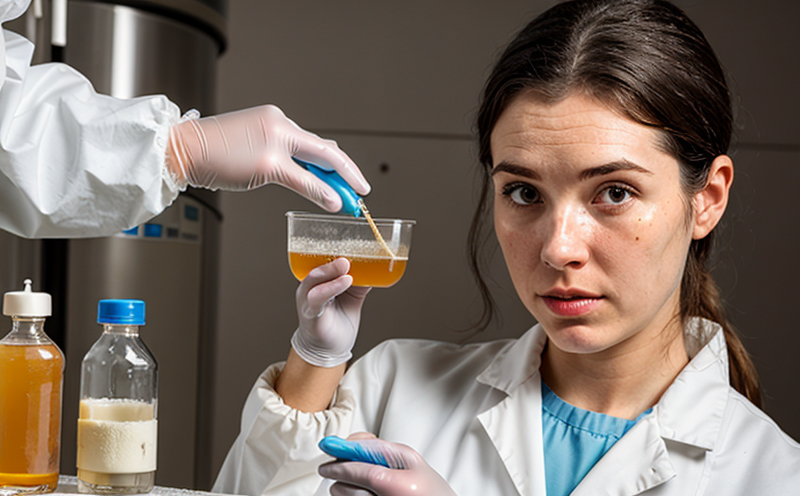EN 1650 Quantitative Suspension Test for Fungicidal Activity
The EN 1650 quantitative suspension test is a standardized method used to assess fungicidal activity. This procedure measures the efficacy of fungicides against fungal pathogens in suspension, providing quantifiable results that are critical for product development and regulatory compliance.
This testing protocol is widely recognized by industry standards such as ISO, ASTM, EN, and IEC, ensuring its reliability and consistency across different regions and applications. The test method is particularly important for the pharmaceutical sector, where fungicidal activity is crucial to prevent contamination during production processes and ensure product efficacy.
The methodology involves suspending a known amount of fungal spores in a solution and then exposing them to varying concentrations of the fungicide under controlled conditions. After incubation, the reduction in viable fungal colonies is quantified using microscopic analysis or other suitable methods. This approach allows for precise determination of the minimum inhibitory concentration (MIC) required to suppress fungal growth.
The EN 1650 test ensures that fungicides meet stringent quality and safety standards, thereby safeguarding public health and environmental protection. Compliance with this standard is essential for manufacturers aiming to achieve market access in Europe and other regions adhering to European Union regulations.
For R&D engineers, the test offers valuable insights into how different formulations perform against specific fungal species, enabling them to optimize product performance. Quality managers can rely on these results to ensure consistent quality control measures are in place throughout manufacturing processes. Compliance officers benefit from this standardized approach as it reduces regulatory risks and ensures adherence to international standards.
The EN 1650 quantitative suspension test is a cornerstone of microbiological testing, providing accurate data for decision-making purposes across various industries including pharmaceuticals, biotechnology, and agriculture. Its robustness lies in its ability to provide reliable results that can be replicated consistently under defined conditions.
Scope and Methodology
| Parameter | Description |
|---|---|
| Fungal Spores | Identified species of fungi relevant to the test. |
| Fungicide Concentration | Varying concentrations tested for efficacy. |
| Suspension Medium | Aqueous solution suitable for fungal growth. |
| Incubation Period | Specific time duration required for observation and analysis. |
| Viable Colony Counting | Microscopic or other analytical methods used to quantify fungal colonies post-incubation. |
The test begins by preparing a suspension of the fungal spores in an aqueous medium. This solution is then divided into samples, each treated with different concentrations of the fungicide under controlled environmental conditions. The samples are incubated for a specified period, after which the reduction in viable colonies is determined through microscopic analysis or other suitable techniques.
The results from this test provide valuable data on the fungicidal activity of various products across diverse applications. This information is crucial not only for developing new formulations but also for ensuring existing products meet regulatory requirements and consumer expectations.
Competitive Advantage and Market Impact
The EN 1650 quantitative suspension test offers significant competitive advantages in the pharmaceutical sector by providing precise measures of fungicidal activity. This allows manufacturers to develop more effective antifungal agents, which are essential for treating various fungal infections.
By leveraging this standardized testing method, companies can ensure their products comply with stringent EU regulations and other international standards, thus facilitating market access in Europe and beyond. Compliance officers can rest assured that their products meet the highest quality and safety standards, reducing potential risks associated with non-compliance.
R&D engineers benefit from this test by gaining valuable insights into how different formulations perform against specific fungal species. This knowledge enables them to optimize product performance, potentially leading to innovations in antifungal therapy. Additionally, the reproducibility of results ensures that any new developments can be consistently reproduced and validated across multiple production sites.
The market impact of this test is profound as it drives innovation in fungicidal technology, ultimately contributing to better health outcomes for consumers worldwide. By ensuring high-quality standards are met, this testing method supports the development of effective antifungal treatments that are vital for combating fungal diseases effectively.
Use Cases and Application Examples
- Pharmaceutical Industry: Development of new antifungal medications.
- Biotechnology Sector: Testing novel biocidal agents.
- Agricultural Products: Evaluating fungicidal efficacy for crop protection.
- Hospital Settings: Assessing disinfectant effectiveness against fungal contaminants.
- Consumer Goods Manufacturing: Ensuring product safety from microbial contamination.
The EN 1650 quantitative suspension test is integral to these applications, providing critical data on fungicidal activity. For instance, in the pharmaceutical industry, this test helps researchers identify promising new compounds for treating fungal infections. In agriculture, it ensures that crop protection products effectively control fungal growth without harming beneficial organisms.
In hospital settings, it verifies that disinfectants are capable of eliminating harmful fungi from surfaces and equipment, preventing cross-contamination. For consumer goods manufacturers, this test guarantees that their products do not harbor dangerous microorganisms, enhancing overall product safety and reducing health risks associated with microbial contamination.





